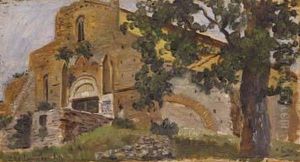Camillo De Innocentiis Paintings
Camillo Innocenti was an Italian painter, born on February 9, 1871, in Rome. He is often associated with the Impressionist and Divisionist movements, though his style also exhibits elements of Symbolism and Art Nouveau. Innocenti showed a proclivity for art at a young age and pursued his passion for painting by studying at the Accademia di San Luca in Rome.
Innocenti's early work was largely influenced by the academic style, but he later became captivated by the innovations of the French Impressionists. He traveled extensively, including a significant period in Paris, which proved crucial for his artistic development. During his time in France, he absorbed the techniques and aesthetics of the Impressionist masters, which he then adapted and integrated into his own distinctive style.
Upon returning to Italy, Camillo Innocenti became part of the Divisionist movement, which sought to break down light and color into their component parts using distinct strokes of color. This technique was similar to that of the Pointillists but with a more dynamic and less rigid application. He became known for his vibrant use of color and his ability to capture the transient effects of light, which endowed his paintings with a particular luminosity and vitality.
In addition to his landscapes and urban scenes, Innocenti was also a notable painter of figures, often infusing his subjects with a sense of introspection and psychological depth. His works often depicted women, sometimes in intimate domestic settings, and he was adept at portraying the textures of fabrics and the subtleties of the human form.
Camillo Innocenti participated in various important exhibitions, including the Venice Biennale, where his work received considerable acclaim. Despite his success, his life was cut short when he died on October 4, 1916, during World War I. Today, his paintings can be found in collections and museums across Italy and beyond, and he is remembered as a key figure in the transition from traditional academic painting to the modernist approaches that characterized early 20th-century Italian art.

